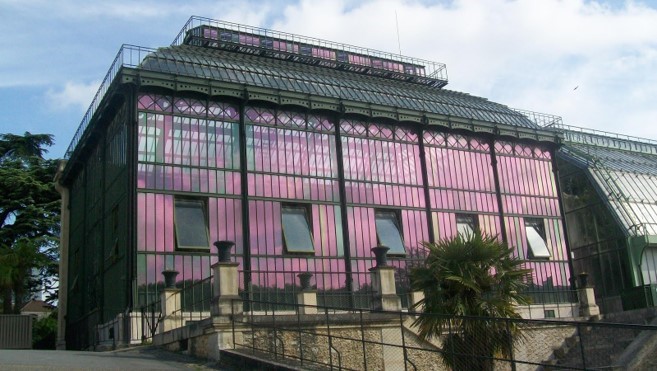Two Gardens, One Senior Exhibition
November 11, 2018
Earlier this year I found myself in Jardin des Plantes in Paris, peering into a greenhouse where Gilberto Rodriguez once worked. He was a Venezuelan botanist, ecologist and carcinologist. He was also my grandfather. My most cherished childhood memories took place in his own tropical oasis in San Antonio, Venezuela, a magical garden around his house where my cousins and I would hide from our mothers and play capture the flag. The most mysterious bit of the garden was home to his cherished species of plants and was naturally forbidden to us kids. Gilberto admired Heliconias, a family of bright, pointy tropical flowers also known as “lobster tails.” Incidentally, he also loved crustaceans. At what I consider the most intriguing point in his career, he had a crab named after him (“finders keepers” applies to scientists too).
I only knew bits and pieces about Gilberto’s work before I traveled around Paris with my mother, coaxing information out of her over many tapas and glasses of wine. I had just finished my study abroad program in Spain, and was ready to start research on my senior thesis on botanical illustrations inspired by my grandfather’s work. Naturally, my first stop was The Jardin des Plantes.
A tall iron gate with even taller trees towering behind it gave way to a winding dirt path. As soon as my mother and I stepped through, the bustling of the city was muted. Guided by her fuzzy childhood memory, we made our way to the Galerie de Botanique located at the heart of the garden. What started out as a royal medicinal herb garden in 1635 is now home to wildly diverse species from all over the globe, where young banana trees live directly across a path from Hare’s tail grass. The plants are arranged based on scientific classifications in neat plots of land on either side of a main walking path. Shallow ponds shelter aquatic plants and numerous frogs that sing to their heart’s content.
I was reminded me of the small pond Gilberto had in his own house. It was elevated, so I had to stand on my toes to look into the murky water and dip my fingers in. Huge aloe plants grew at the base, and so did a row of palm trees that lead into the main entrance. Walking through the Jardin des Plantes examining the different species of plants made me wonder what exactly Gilberto’s work has consisted of during his time here. As a kid I had only known him as my grandfather, but he had been so much more to his children and to the scientific community. Over the course of my week in Paris I realized that there had been family history buried by both time and my growing distance from Venezuela.
Something I will never be able to recover are his mysterious letters. From 1955-1957 Gilberto wrote letters from Miami, where he was getting his masters in marine biology, to my grandmother in Venezuela who was his girlfriend at the time. Two years later, they married. His letters are a frequent topic of discussion amongst his children to this day, but no one besides my grandmother ever laid eyes on them after they crossed the Atlantic Ocean. Word is he had a great sense of humor, but no one knows exactly what was said in the letters or where they are today. Hearing about the letters from my mom was both intriguing and irritating. Why did no one bother to save them? “He was a private person,” was all my mom could say in response.
When Gilberto moved to Paris in the 1970s his family went with him. On their first day of class, Gilberto took the metro and accompanied each child to their respective school. My mother and her twin sister were sent to l’Ecole Active Bilingue. On the second day, they had to find their way on their own. This brought to mind my own first day of school in the States, when my parents walked each one of my sisters to our classrooms. One by one we wished each other good luck and felt our stomachs dip as we entered classrooms full of children speaking quickly and incomprehensibly.
I reflected on these similarities as my mother and I walked the route she used to take to school, only to find out that l’Ecole Active Bilingue had closed a few years ago. Then, we visited her old home at 9 Boulevard de Magenta Diciem and looked up at the second floor balcony. We turned to look across the street at the Hospital Lavoisier where my grandmother Selva worked while my mother and her siblings were in school. We browsed the Gibert Jeune bookstores where my mother bought her school supplies. We ordered her favorite crepes from a street vendor. We stared at artworks at the Louvre, Pompidou, Musée d’Orsay and Musée Picasso. We visited the graves of Edith Piaf and Oscar Wilde at the Pere Lachaise Cemetery.
On our last day in Paris, we returned to the garden to say goodbye to Gilberto. It was chilly. The frogs croaked louder than ever. “At least I can visit him here,” I thought.
I recalled an afternoon in his garden in Venezuela when my youngest sister, Eleonora, came across a bright red scorpion. As any five-year-old would do, she knelt next to it and reached her hand out to touch it. And as any poisonous scorpion react, it tried to sting her. Her screams bounced off the brick walls and soon we were surrounded by twelve worried adults. Gilberto, more intrigued than concerned, captured the scorpion in a glass jar and taught us about pointed out to us the pincers and the sting like it was a specimen.
His fascination with animals and their habitats led him to study marine biology. He wrote his graduate thesis on the marine communities of Margarita Island off the coast of Venezuela. Decades later, I would frequently visit this island on family vacations, but for a reason unbeknownst to me he never came with us. He went on to get his PhD at Wales University, all the while going on expeditions to study freshwater crabs. He pioneered marine ecological studies in Venezuela, founding the Center of Ecology at the IVIC (Venezuelan Institute of Scientific Investigations) in 1970. Still, when I attended his wake at the IVIC in 2004, I didn’t comprehend the magnitude of losing him.
With my senior art exhibition I can only hope to communicate the fascination with nature that I share with my grandfather, and hopefully it will spark a conversation about the ecological issues that are threatening species all over the globe. Learning about the important contribution Gilberto made to the scientific community not only inspired my senior thesis, but also made me see Venezuela in a positive light, something I haven’t been able to do in a long time.
Back at the Airbnb I downsized my luggage, leaving behind old clothes. Our next and final stop was Madrid, where we would go on to visit more museums, try tapas, and ponder over family gossip.











Laurie Schoenberg • Jun 12, 2019 at 4:44 pm
So enlightening! Puts everything into perspective. Thank you for sharing. 😊